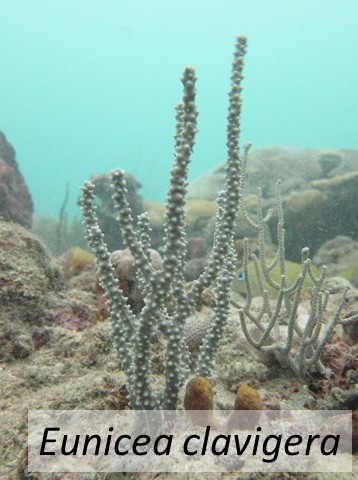
Family: Plexauridae
Common Name(s): Knobby candelabra.
Colony Form: Candelabra or bushy with few long, irregular branches; to 1.8 m in height.
Axis: Cylindrical in cross-section.
Branches: Long branches 5-15 mm in diameter (not including calices).
Apertures: calices tubular, prominent, with lower lip longer than upper one.
Mucus: Absent
Color: Dark brown to black. Calyx tube lighter than the rest of the colony, and polyps with pale brown tentacles.
Sclerites: Polyp armature: robust rods 0.15-0.57 mm and small rods 0.08-0.18 mm; little sclerite bodies and octoradiate forms in tentacles. Axial layer: ornate, lavender or purple spindles, or irregular bodies, to 0.25 mm. Middle layer: robust spindles 0.58-2.66 mm long, 0.08-0.72 in diameter. Surface layer: small foliate and irregular clubs 0.07-0.19 mm long.
Habitat: Semi-exposed reefs in 10-30 m.
Distribution: Widespread: Bahamas, Bermuda, South Florida, Gulf of Mexico, and throughout the Caribbean Sea.
Notes: Very long polyps, among the largest in Eunicea. Branch thickness and polyp length highly variable. Sánchez (2009) found two morphotypes (except for the type Material): a slender form ~20 cm tall with branches to 12 cm long, often with few, chiefly small, club sclerites, larger polyp rods and robust middle layer sclerites visible at the surface. The thick form reaches ~40 cm tall, with thick branches to 2 cm across near the base, mostly to 20 cm long.
References: Bayer (1961), Cairns (1977), Sánchez & Wirshing (2005), Sánchez (2009).
Similar Species: Eunicea asperula










